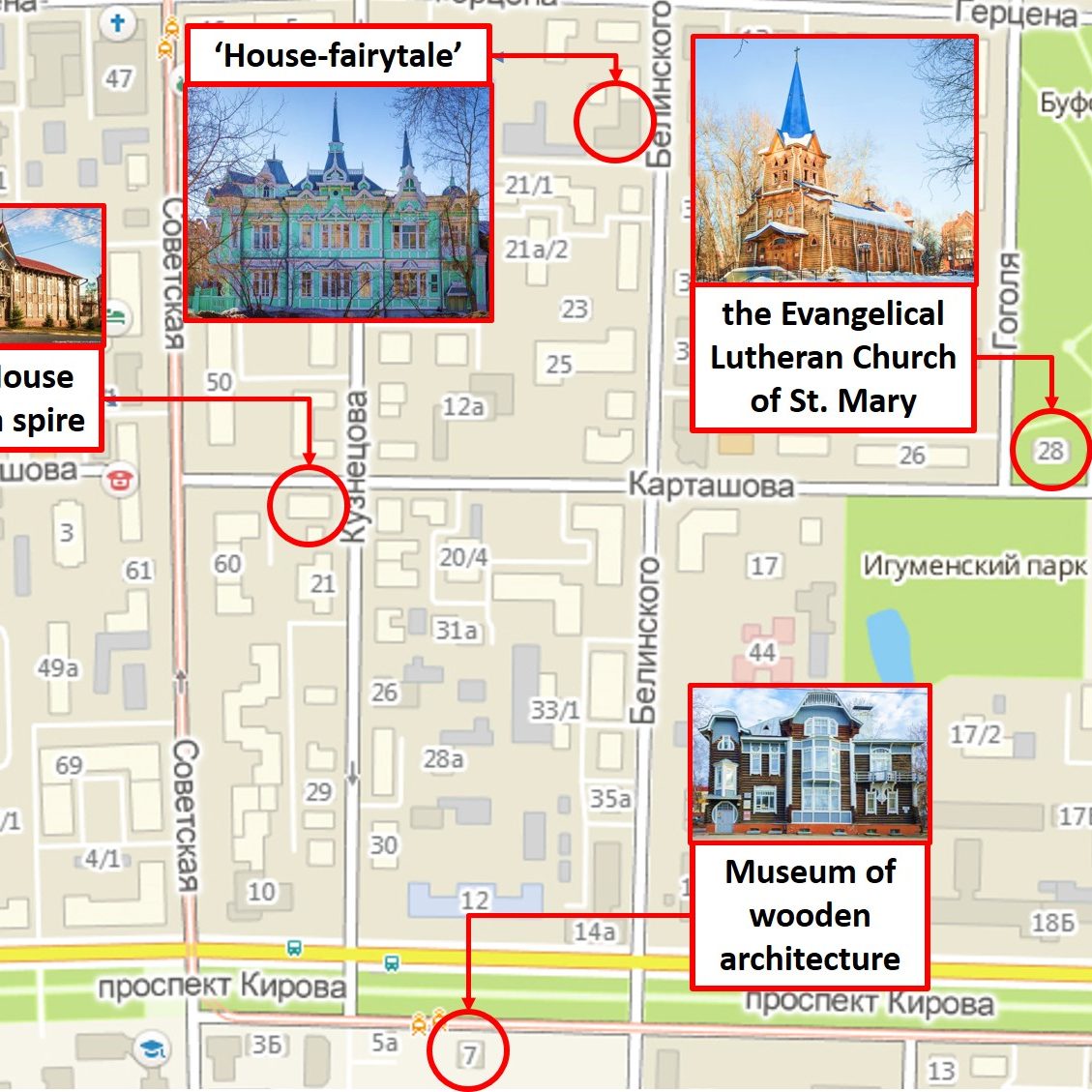Kuznetsov Street - 700 meters of wooden architecture!
Kuznetsov Street is the one of the most beautiful, coziest and quietest places in Tomsk. All along both sides of the street are small (based on Russian standards) or large (based on my perception) wooden houses, strongly reminiscent of the time period when Tomsk was still a young city. Kuznetsov Street runs from Herzen Street to Kirov Avenue, and is named in honor of the outstanding Tomsk academician, Vladmir Dmitrievich Kuznetsov (1887-1963) ("Vladimir Kuznetsov").
The first time I walked along Kuznetsov Street was a damp summer evening--the grey early evening light contrasted with the colors of the houses, making the dark wood of the logs even starker, and the painted window frames and wood lace more colorful. Each house was unique in its style, each with its own style of shutters, of window frames and lattice work. The presence of the decorative details on each house, and the countless windows, sparked my curiosity as to how this style became emblematic of Tomsk--how such a decorative style came about in the middle of Siberia, before central heating, where it seemed that staying warm in winter would be the main priority.
Photo credit: Adele Lonas
The length of this street is a little more than 700 meters, but there are more than 10 beautiful houses demonstrating the use of wooden architecture. Here you can observe the evolution of the craftsmanship and design specific to Tomsk architecture, and learn about famous figures of Russian culture, science and art.
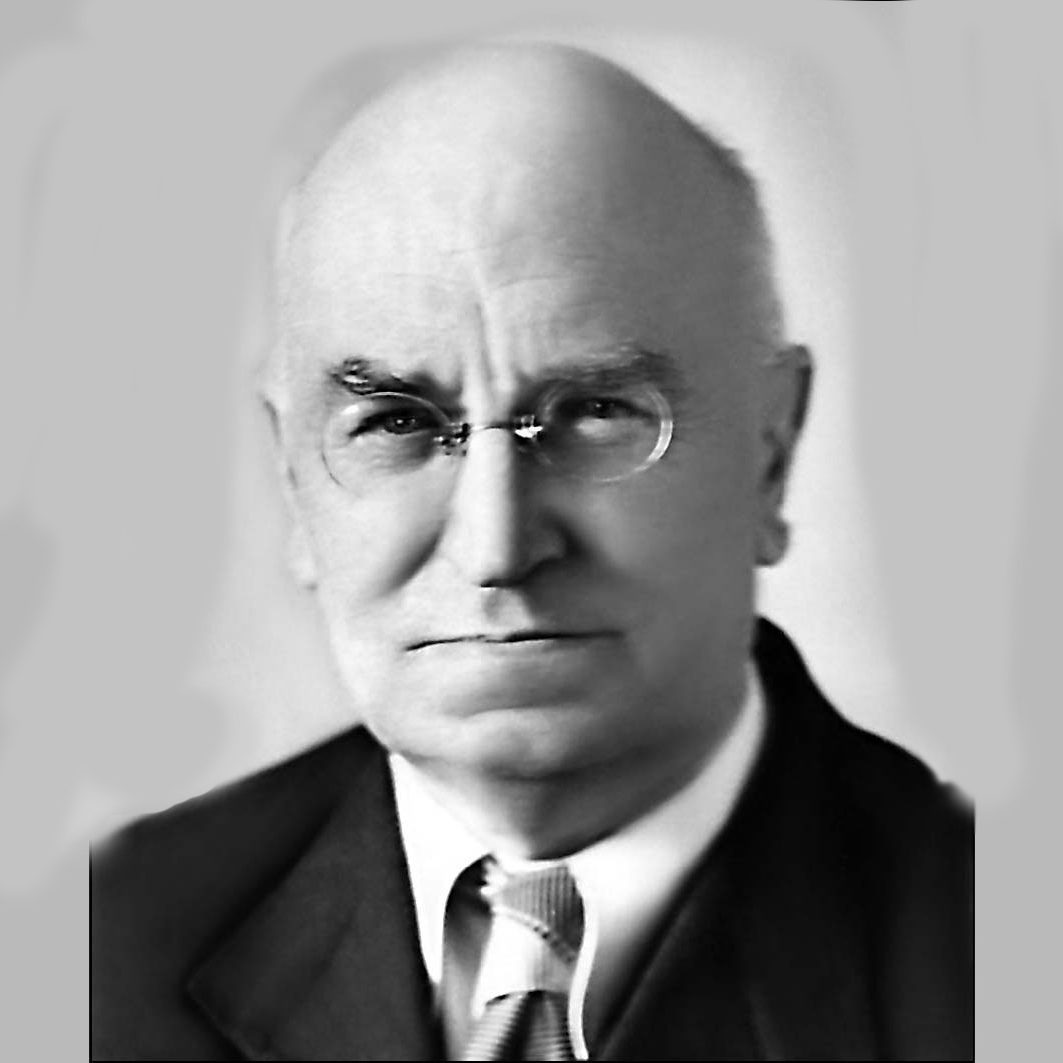
Vladimir D. Kuznetsov
Kuznetsov Street was named for Vladimir D. Kuznetsov–laureate of the Stalin Prize (1942), Doctor of Physical and Mathematical Sciences, Academician of the Academy of Medical Sciences of the USSR, and the first Hero of Socialist Labor in Tomsk (1957). As Director of the Siberian Physics and Technical Institute at Tomsk State University for 30 years, during World War II Kuznetsov carried out research on armor penetration and was one of the leaders of the committee of scientists organized to help the war front ("Vladimir Kuznetsov").
"Even an army of local historians and architects can not clearly determine who has built it and when!"
On the day of our guided tour, at the first intersection walking south on Kuznetsov Street we saw a two-story wooden house known as "The House with a Spire" (№17). The house, which sports a modernist Art Nouveau style, dates to the end of the 19th century and belonged to the pediatrician V. I. Vasilkovy. Our guide told us that it is considered to have the most complex and tangled history of the houses on Kuznetsov Street so much so that even an army of local historians and architects haven't been able to determine who built it and when. However, in 1902, it housed the first private music school in Tomsk (since 1907 known as The School of Mary Shilovskaya) ("Residential Building of the Late XIX Century").
№18 – This house seemed to us to be the one house whose design took the Siberian winter into consideration...since winters are harsh in Siberia, people would try to keep the heat in their houses by making the windows very small and ceilings low. We were told that its construction was typical of Siberian houses built in the spirit of the 18th century. ("Улица Кузнецова (Томск)"). We also learned that it had belonged to Pepelyaeva Nikolai Mikhailovich (1858-1916), chief of the Tomsk garrison, and father of Victor and Anatoly Pepelyaeva, prominent members of the revolutionary events of 1917 and the Russian Civil War.
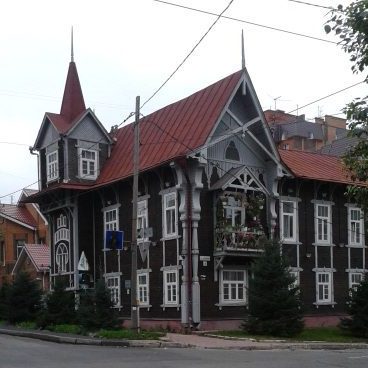
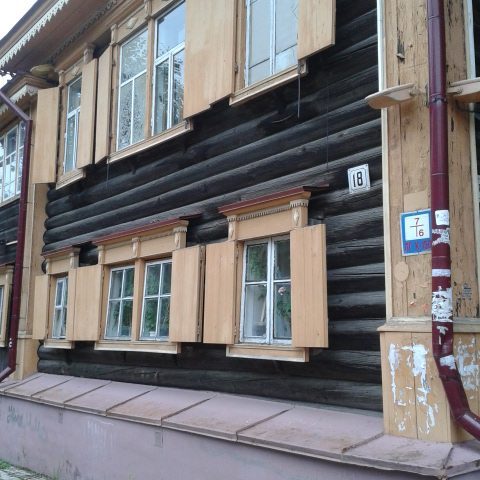
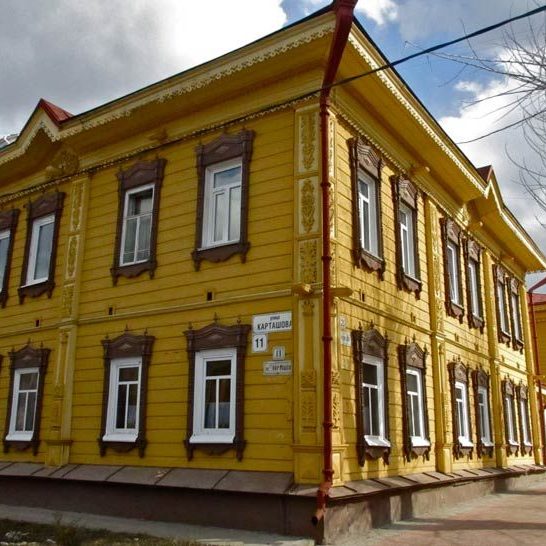
№17 - The House with a Spire
Photo credit: Adele Lonas
№18
Photo credit: Adele Lonas
№20
Photo credit: Janina Szubzda
If you look at the picture on the right, you'll see the house №20, which is painted a sandy yellow and is decorated with unique platband, or carved frames, around the windows, and along the facade and roof. This style of decoration is typical for Tomsk craftsmen. Oddly, the sandy yellow siding and decorative brick red trim was oddly reminiscent of the colonial houses along much of the east coast of the United States. Only here on Kuznetsov Street, learning that Lidia Delektorskaya the lifelong personal assistant of the great French painter of the 20th century Henri Matisse was born in 1910, definitely added an unexpected and exciting element of fascincation (Watt, 2010).
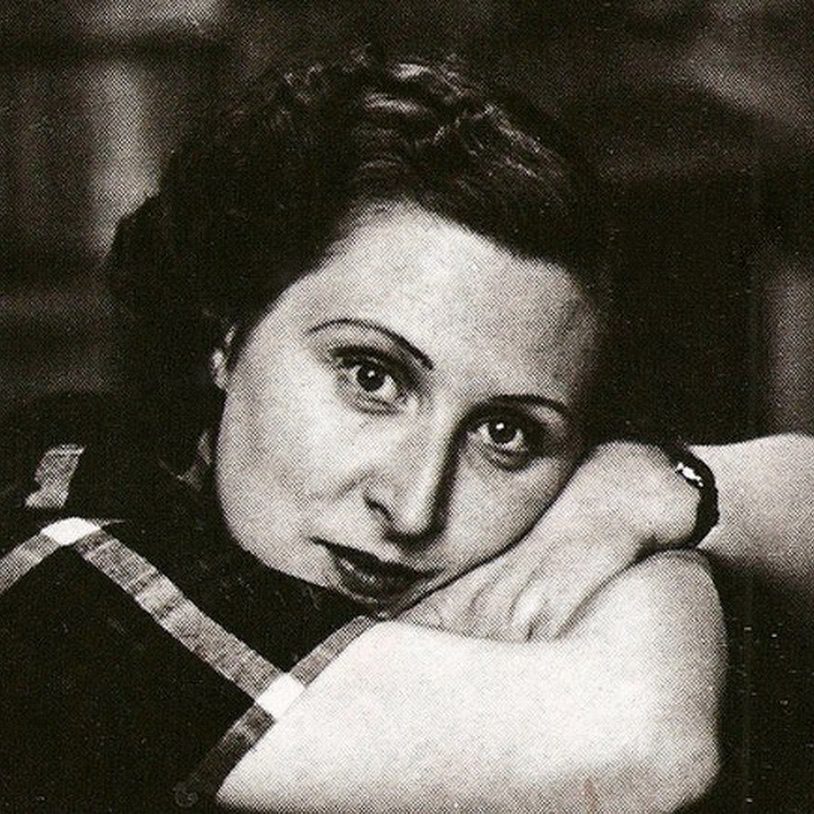
Lydia N. Délectorskaya
(Born June 23, 1910, in Tomsk, died March 16, 1998, in Paris). Lydia fled Russia for France during the Russian revolution. She became Henri Matisse 's model and personal assistant in 1932, until his death in 1954; after Matisse's wife left him in 1939, Lydia became his lifelong comrade and studio manager. Additionally, as his model and muse, Matisse produced approximately 90 paintings of Lydia, and she authored two books on Matisse and his work relevant to the time period she was with him. (Watt, 2010).
House №24, more a mansion than a house and built in the middle of the 19th century, is painted the same mustard yellow as the house at 20 Kuznetsov St., invoking the same memory of colonial neighborhoods in the U.S. However, as we wandered behind the main house, we discovered a large courtyard, surrounded by an ensemble of four more wooden houses! The house at the back of the courtyard was our favorite the wooden trim seemed a tad more elaborate, and the trim just a touch more reddish than on the other houses...though it could have just been the slant of the afternoon light.
№26 – At first we mistook this apartment house for a mishap it is one of the few stone buildings on Kuznetsov Street and has only a single wooden balcony on the front, and one on the side, both of which looked unexpectedly heavy and randomly placed. However, the very unexpectedness made it equally intriguing. The former apartment house of D. D. Akulova (modernist style, architect A.I. Langer), the building is now the Tomsk Oblast TB Dispensary ("Улица Кузнецова (Томск)").
House №30 reminded us of the first house we saw, 17 Kuznetsov Street, due to the stark contrast between the dark timber siding and the white trim. Built by the architect V. F. Orzheshko, the house was divided into apartments, mostly for academicians and professors. From 1930-1941, the Soviet radio physics professor V.N. Kessenikh lived in this house; and E. Denisov, a famous Tomsk composer, lived in it from 1929-1951 ("Residential Building of the Late XIX Century"). Despite its similarity to №17, № 30 differs from the other houses because of its flat decorative aprons.
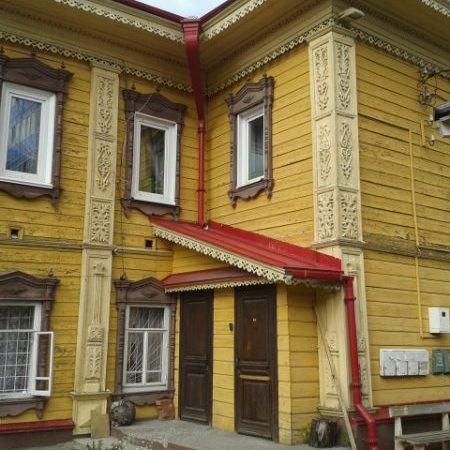
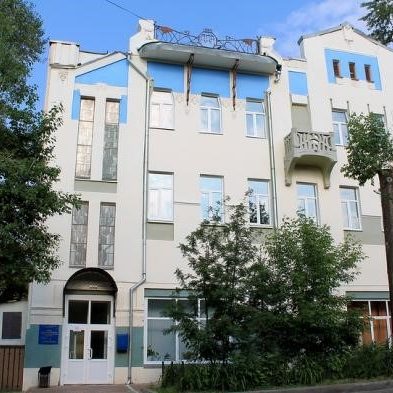
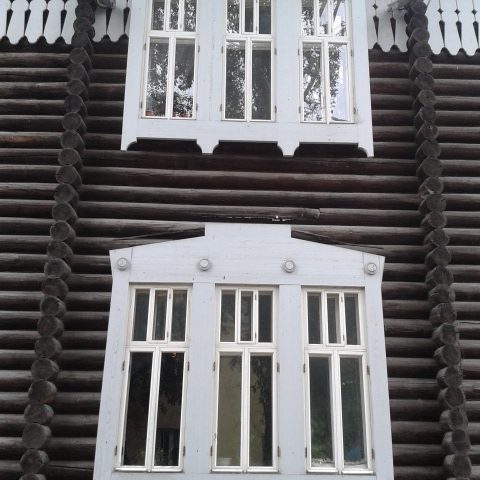
№24
Photo credit: Adele Lonas
№26
Photo credit: Brada
№30
Photo credit: Adele Lonas
If you would like to enjoy more of the wooden architecture famous in Tomsk, you can venture to the house of the Khomich architect. This building resembles an emerald palace and in Tomsk it is called a "Fairytale House". Or, you may walk south on Kuznetsov street until you come to the house of the architect Kryachkov where there is the Museum of Wooden Architecture. After a tour of the museum, you should go to the Buff-garden where you'll find the Evangelical Lutheran Church of St. Mary, well-known around Siberia since the Choir of Tomsk State University often performs there. To reach it you should turn east at the intersection of the "House with a Spire".
Personal veiw
Walking along Kuznetsov Street is like walking through an archeaological time warp. In knowing of the historical figures and individuals whose lives began or played out in the houses within this 700 meter stretch, the street sparked my curiosity... Also, seeing the detailed wooden lace framing each of the windows and lining the eaves, the tufts of linen insulation peeking from between the logs, and the decorative wooden overhangs, made walking along the street a treat, both visually and intellectually. I found myself wondering about the interior of each house and about the lives that are presently playing out inside, within a distinctly different historical dynamic. Not knowing if someone else born on this street might become a Lydia Delectoroskaya, a composer or a famous mathemetician, made me wish I could knock on each door meet every resident... while coming to the house on the corner of Kuznetsov and Herzen Streets made me wonder what it would be like to live in a house that is physically aslant and falling apart slat by slat, but still hauntingly beautiful. - Adele Lonas, CSU
Glossary
Window shutter is a decorative frame window or a doorway.
The window shutters is a solid and stable window covering. In Russia window shutters traditionally have been constructed from solid wood.
Eaves is portions of roof that project beyond the outside walls of a building.
Facade is a main exterior side of building.
Wood carving is a form of woodworking. Traditionally, masters of wood carving are using different kinds of knives called bents, chisels and gouges
Spire is a tapering conical or pyramidal part of building which stands on top of the roof.
References
- "Residential Building of the Late XIX Century." qrtomsk.ru. Retrieved from qrtomsk.ru/ru-RU/Places/10.
- "Residential Building of the Late XIX Century." qrtomsk.ru. Retrieved from qrtomsk.ru/ru-RU/Places/18.
- "Vladimir Kuznetsov." The Free Dictionary. Retrieved from http://encyclopedia2.thefreedictionary.com/Vladimir+Kuznetsov.
- "Улица Кузнецова (Томск)." (n.d.). Википедиа. Retrieved from https://ru.wikipedia.org/wiki/Улица_Кузнецова_(Томск)
- Watt, G. (2010). Lydia Delektorskaya. The British Journal of General Practice. 60.577. P. 626–627.
Created by Adele Lonas and Ilya Dmitriev
Additional information
Museum of Wooden Architecture
Located at 7 Kirova Street, at the eastern end of Kuznetsova Street, the Museum of Wooden Architecture offers a closer experience of the wooden lace unique to the houses of Tomsk, as well as of other wooden artifacts--of household and decorative items typical of Tomsk and Siberia. The museum, housed in what was Andrei Kryachkov's house, is an example of the Art Nouveau Style also seen at 17 Kuznetsova Street (3). Because so many of the wooden houses unique to Tomsk have been destroyed by fire over time, the museum has an important role in preserving Tomsk cultural and architectural history.
